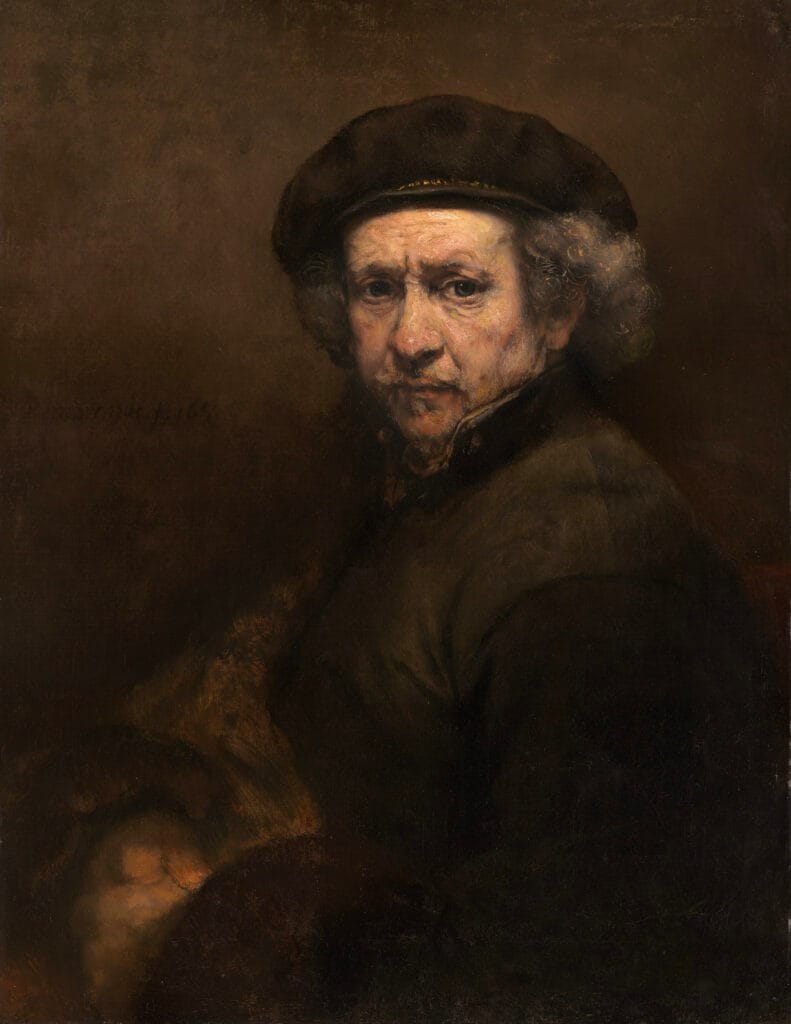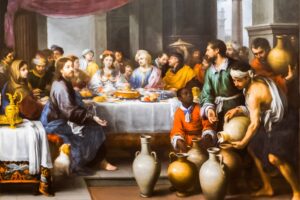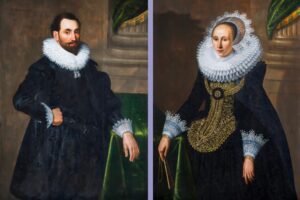The Return of the Prodigal Son – Rembrandt van Rijn, 1661–1669
In a darkened room, a father lays his hands upon the shoulders of a kneeling son. The son is ragged, shoeless, broken. The father is old, cloaked in red, eyes filled not with judgment but with grief, compassion, and something deeper—recognition. This is not just a biblical parable. In Rembrandt’s hands, it becomes a human truth.
Painted in the final years of his life, The Return of the Prodigal Son may be Rembrandt’s most personal work. A painting not of spectacle, but of stillness. Not of drama, but of forgiveness.
The Scene Before Us
At the center, the prodigal son kneels—head bowed, body slumped, clothes torn. One sandal dangles from his heel, the other lost entirely. He is no longer proud. No longer certain. He is simply home.
The father leans over him, hands resting on his son’s back—two hands, each painted differently. One strong, firm, masculine. The other soft, tender, almost maternal. As if to say: mercy holds both strength and gentleness.
To the right, a standing figure watches—believed to be the elder brother. His expression is cold, arms crossed in rigid judgment. He is there, but not present. Physically near, spiritually distant. Behind him, others hover in shadow. Observers. Witnesses. Or perhaps, parts of ourselves.
The Deeper Meaning
Rembrandt does not paint sin, nor punishment. He paints return. And more importantly, he paints welcome. There is no grand feast here, no music or revelry. Just quiet reunion.
In his own life, Rembrandt had known loss, shame, exile—both financial and emotional. He understood the fatigue of the wanderer, the pride of the onlooker, and the silent ache of the one who waits. This is not performance. It is testimony.
The painting asks us gently: Who are you here? The kneeling child? The waiting parent? The cautious sibling at the edge of the room?
Forgiveness, in Rembrandt’s world, is not just divine—it is deeply human.
A Moment Caught in Time
There is no movement here. Only stillness. The kind of stillness that lives in the pause between two heartbeats—when anger softens, when defenses fall, when hands reach across silence.
In this moment, the return is complete. The past does not vanish. It simply no longer holds power. And for a quiet, eternal second, the world is made whole again.
About Artist

Rembrandt Harmenszoon van Rijn (1606–1669) was a Dutch Golden Age painter and printmaker widely considered one of the greatest visual artists in history. Unlike many of his contemporaries, he never traveled to Italy but was nonetheless deeply influenced by the Italian Baroque, particularly the work of Caravaggio. Rembrandt was a master of a wide range of subjects, including portraits, landscapes, and biblical and historical scenes. His later life was marked by financial hardship, but his artistic output remained at a masterful level, with his later works showing an even greater emotional and psychological depth.
Artistic Style and Techniques
Rembrandt’s style is defined by his profound humanism and his masterful command of light and shadow, a technique known as chiaroscuro. He used this dramatic contrast to create a powerful sense of emotion and to draw the viewer’s eye to the most important parts of the canvas, such as the face or hands of a subject. His technique became increasingly loose and expressive over time; his late works are known for their impasto—thick, textured layers of paint that give his canvases a sculptural quality. This expressive brushwork and his ability to capture the inner life and spirit of his subjects set him apart from his peers.
Notable Works
Rembrandt’s prolific career produced an incredible number of masterpieces.
- The Night Watch (1642): A monumental group portrait of a civic militia company, this painting broke with tradition by depicting the subjects in a dynamic, action-filled scene rather than a static, formal pose.
- The Anatomy Lesson of Dr. Nicolaes Tulp (1632): One of his early masterpieces, this painting captures a public dissection with a vivid sense of realism and psychological intensity, demonstrating his genius for group portraiture.
- The Return of the Prodigal Son (c. 1669): A profoundly moving late work that is celebrated for its deep emotional and spiritual resonance, using light and color to convey a sense of forgiveness and love.
- The Storm on the Sea of Galilee (1633): Rembrandt’s only known seascape, this painting is a thrilling depiction of the biblical miracle. It captures the chaotic and terrifying scene of a boat being tossed by a ferocious storm. The dramatic diagonal of the boat and the masterful use of tenebrism—the stark contrast between the stormy gloom and the flash of light on the waves and the terrified faces of the disciples—perfectly embodies the drama of the Baroque. One of the figures in the boat, looking out at the viewer, is widely believed to be a self-portrait of the artist himself. Unfortunately, this painting was stolen in a major art heist in 1990 and its whereabouts remain unknown.



